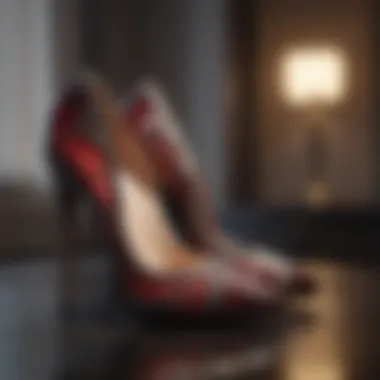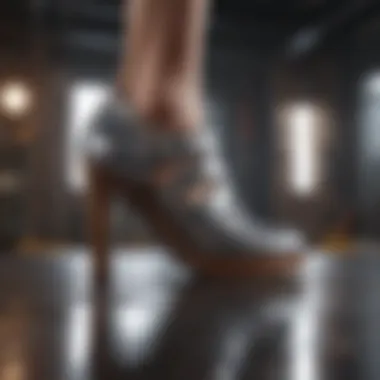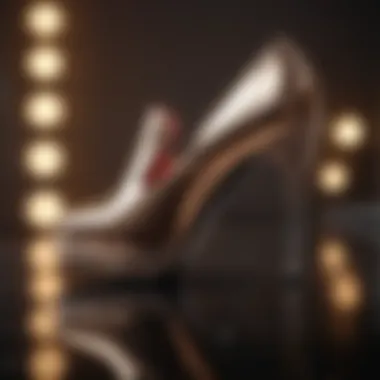Top Heel Brands Shaping Fashion Trends


Intro
The world of heels is a realm where art meets function, a delicate balance that can dictate not just how we look, but also how we feel. In this exploration, we'll take a close look at some of the top heel manufacturers that have carved their niche in the fashion landscape. Rather than merely produce footwear, these companies create statements and stories that resonate with women from all walks of life.
Dive beneath the surface, and you'll find that their impact goes far beyond aesthetics. The craftsmanship involved, the innovations applied, and their approach to sustainability shape the direction of fashion trends. With a multitude of styles, each brand offers women options that cater to their unique needs—whether that’s comfort for everyday wear or a daring design for a special event.
This investigation aims to paint a vivid picture of who these brands are, their contribution to current styles, and how they are responding to the pressing conversation around sustainability. By examining these elements, we can gain a deeper understanding of the interplay between function and fashion in the realm of heels.
Preamble to the World of Heel Companies
The significance of heel manufacturers goes beyond mere footwear; they are cultural icons that encapsulate elegance, status, and individuality. This article serves as a deep dive into the intricate universe of heel companies, emphasizing their impact on fashion trends and consumer behaviors. In recent years, heels have transformed from an exclusive style choice to an essential element of everyday wardrobes. This evolution reflects not only aesthetic preferences but also shifts in societal values regarding comfort and sustainability.
Historical Context of Heels in Fashion
Heels have a fascinating history that dates back centuries. Initially worn by Persian cavalrymen to secure their feet in stirrups, heels made their way onto the European fashion scene in the 16th century. The footwear morphed into a symbol of luxury and higher social standing. For instance, King Louis XIV of France famously wore heels, and it wasn’t uncommon for the nobility to select towering styles to project their social status. These early designs often featured elaborate embellishments, with the higher the heel, the more affluent the wearer.
Fast forward to the 20th century, heels took on various forms, from Mary Janes to stilettos, each reflecting the zeitgeist of its time. The post-war era saw a resurgence of femininity in fashion, spotlighting iconic heel styles associated with glamour and desirability. Icons like Marilyn Monroe and Audrey Hepburn set trends that resonate even today. The psychological aspect behind these designs cannot be overlooked; they often empower wearers, allowing for an expression of personal style and mood.
Current Trends in Heel Styles
Today's heel market is anything but static. The diverse array of choices available is astounding, catering to a broad audience with varying tastes. From kitten heels to block heels, the evolution of designs emphasizes practicality without compromising on flair. Currently, there's a noticeable tilt towards hybrid styles that merge comfort and design. The rise of chunky heels exemplifies this trend, allowing wearers to stride confidently through day and night.
Moreover, the surge in sustainability makes eco-conscious materials a focal point in heel production. Brands are experimenting with recycled fibers and ethically sourced leathers, appealing to a growing demographic that values environmentally friendly fashion. The fusion of tradition with innovation shapes the future, marking a significant shift in how heels are perceived. Women of all ages today are not just wearing heels; they are making informed choices about their fashion statements, seeking pieces that resonate with their values.
"Footwear is not just style; it is also a voice expressing the time and values of society."
As we navigate through the intricate world of heel companies, understanding these historical contexts and current trends not only enriches our appreciation of fashion but also informs our choices. Ultimately, the landscape of heel design reflects much more than aesthetics; it embodies cultural expectations, comfort desires, and sustainability efforts that shape the footwear industry.
Leading Heel Companies to Consider
When it comes to heels, there’s no shortage of brands that have carved a niche for themselves. Exploring leading heel companies is crucial because these are the brands that not only dictate trends but also set standards for quality and style. Each company brings something unique to the table, impacting how consumers perceive fashion and footwear. For women of all ages, knowing these brands helps in making informed choices about style, comfort, and price.
Brand Profile: Christian Louboutin
Signature Red Soles
The red soles by Christian Louboutin aren’t just a matter of aesthetics; they symbolize luxury and exclusivity. This distinguishing feature has become a status symbol within the realm of fashion. The color red evokes a sense of boldness and glamour. Women often choose these shoes as an essential part of their special occasion outfits. However, the downside is that these coveted heels can leave a dent in your wallet, so they’re often viewed as a splurge rather than a staple.
Craftsmanship and Luxury
Christian Louboutin is synonymous with impeccable craftsmanship. Every pair of shoes is handcrafted with an eye for detail that sets them apart. This dedication to luxury materializes in beautiful designs and a fit that allows for elegance without sacrificing comfort. While the price tag may be steep, the quality ensures that these heels are an investment that can last for years. However, it’s worth noting that this focus on luxury sometimes leads to limited availability for distinct designs, leaving some consumers wanting more.
Iconic Designs
From the "Pigalle" to the "So Kate," these iconic designs play a pivotal role in what makes Christian Louboutin beloved among fashion aficionados. Each design not only highlights aesthetic beauty but is also built to be visually arresting. These are shoes that catch the eye and make a statement. Nevertheless, the avant-garde designs can sometimes compromise comfort, making them less suitable for long wear.
Brand Profile: Manolo Blahnik
Timeless Elegance
Manolo Blahnik’s creations prioritize timelessness, blending classic styles with modern flair. The elegance and sophistication of his designs are often considered evergreen in fashion. This characteristic draws in those looking for shoes that can be versatile enough to wear across seasons. On the flip side, while they may not always follow extreme trends, they can sometimes miss out on the youthful exuberance sought by a younger demographic.
Artistic Influences


Each pair of Manolo Blahnik shoes tells a story, heavily influenced by art and culture. This distinctive touch elevates the footwear into more than just shoes; they're pieces of art. Many who wear them feel connected through this sense of creativity. Yet, this artistic approach might not always cater to all tastes, as some find the designs a bit too intricate for everyday wear.
Celebrity Collaborations
Collaborations with celebrities have propelled Manolo Blahnik into pop culture, creating visibility and hype. When the likes of Sarah Jessica Parker wear his designs on television, it cements the brand in mainstream fashion lore. While this exposes the brand to a wider audience, it can create unrealistic expectations for everyday wear, as these celebrity-worn shoes may be perceived as unattainable dreams for average women.
Brand Profile: Jimmy Choo
Fashion-Forward Styles
Jimmy Choo's commitment to pushing the envelope with fashion-forward styles is what keeps them at the forefront of the industry. Unique cuts and daring designs often catch the eye, appealing to a demographic that values trendsetting over tradition. However, this boldness means that the shoes may not be suitable for all occasions, especially more formal or conservative environments.
Global Reach
With stores across the globe, Jimmy Choo's reach and popularity signify its place in consumer culture. This availability makes it easier for women everywhere to find and wear these fashionable pieces. Still, maintaining that level of quality internationally can pose challenges, leading to inconsistency in craftsmanship across different markets.
Sustainability Initiatives
Jimmy Choo has taken steps towards sustainability, recognizing the changing priorities of consumers. By focusing on eco-friendly practices, the brand aligns itself with modern consumer values. While these moves enhance brand image, there is the challenge of ensuring that all products genuinely reflect sustainable practices, which can be difficult to verify.
Brand Profile: Steve Madden
Trendy and Affordable
Steve Madden is recognized for creating trendy styles that are accessible to a broader audience. This ability to blend current trends with affordability makes them a favorite among younger shoppers. The downside, though, is that some may critique the quality, feeling that affordability sometimes leads to compromises in durability.
Diverse Collections
Steve Madden's diverse collections cater to varied styles, making it easy for consumers to find something for any occasion. Each collection features shoes that can transition from day to night with minimal effort. Nonetheless, the sheer volume of choices may overwhelm some consumers, making decision-making more difficult.
Influencer Marketing Strategies
The clever use of influencer partnerships has allowed Steve Madden to appeal directly to a generation accustomed to social media. This strategy effectively captures attention and drives sales. However, relying heavily on influencers might alienate consumers who prefer a more classic brand image, and can lead to transient popularity.
Brand Profile: Cole Haan
Combining Comfort and Style
Cole Haan has mastered the art of blending comfort with style, making them popular for everyday wear. This combination appeals especially to professionals looking for functionality without compromising on aesthetics. However, some styles can be pricier than conventional brands, which may discourage the most budget-conscious shoppers.
Innovative Technology
With innovations like the use of cushioning technology, Cole Haan places emphasis on comfort particularly in professional settings. This leads to a focus on being suitable for long hours of wear without discomfort. Yet, this can sometimes take away from classic styling, causing a tension between comfort-driven and fashion-driven consumers.
Timely Fashion Collaborations
By collaborating with contemporary designers, Cole Haan taps into fresh aesthetics and brings timely pieces to the market. This reaffirms their relevance in a fast-moving fashion landscape. The challenge remains, though, in whether these collaborations can maintain the brand's longstanding values while also appealing to new audiences.
The Evolution of Heel Design
The journey of heel design has been nothing short of a saga, intricately woven into the fabric of fashion history. Heels have transcended the bounds of mere footwear into significant cultural symbols. As tastes and needs shift, heel design has evolved not only to reflect style but also to respond to the demands of comfort and sustainability. This evolution signifies a critical juncture in understanding fashion as it adapts to societal changes.
Materials Influence on Design
Leather versus Synthetic Alternatives


When choosing heels, the type of material plays a crucial role. Leather is often regarded as the gold standard, known for its durability and sophisticated look. Its ability to mold to the foot over time makes it a beloved choice among wearers looking for both style and comfort. However, synthetic alternatives, such as polyurethane or PVC, have gained traction for their affordability and wider variety of styles.
Leather heels can be luxurious but often come with a hefty price tag. On the flip side, synthetic options cut the costs but may lack breathability. This contrast leads to a more divided choice among consumers, who weigh long-term investment against immediate satisfaction. Ultimately, for many, the decision hinges on lifestyle and context—what works for an evening gala may differ greatly from a day in the office.
Sustainable Material Choices
The rising awareness about environmental impact shifts focus towards sustainable choices in heel production. Brands are now experimenting with options like recycled materials and organic fabrics. The green movement has made these materials appealing because they lessen the ecological footprint. Plus, they often come branded with ethical certifications, enhancing their allure.
Sustainable materials can be a strong selling point, especially for the conscious consumer. However, one of the challenges remains that these eco-friendly options sometimes compromise on style or require a learning curve about care and maintenance. Still, as technology improves, the gap between aesthetic appeal and sustainability continues to narrow.
The Future of Eco-Friendly Heels
Looking ahead, the path of eco-friendly heels seems promising with innovations like plant-based materials and biodegradable components. Brands are beginning to identify how they can produce beautiful, stylish heels without the environmental costs traditionally associated with shoe fashion. This shift isn't just a trend; it's quickly becoming a necessity in the eyes of discerning consumers.
The unique feature of this future is the blend of pleasant style with responsibility. For example, companies are introducing heels that not only look chic but also come with a reduced impact on the planet. However, the drop-off point could come with price; higher costs for sustainable goods still deter some buyers, even when sessions of waste reduction are highlighted.
Innovations in Heel Construction
Comfort-First Approaches
The emphasis on comfort is reshaping heel construction like never before. Designers are creating heels with features that prioritize foot health. From thicker soles to cushioned insoles, the modern heel takes into consideration the practicalities of daily wear. Women, after all, don’t want to sacrifice comfort for style, which is why many brands are bridging the gap with functional designs.
This shift promotes the idea that one doesn't have to choose—fashion and comfort can coexist. Unfortunately, this means some very traditional styles may fade away, as heel heights might lessen. Nevertheless, the greatest joy will be in liberated feet from pain with a refined silhouette that still impresses.
Adjustable Features
The incorporation of adjustable features into heels is another innovative trend. Heels that can adapt to the wearer's needs provide expanded functionality. Whether it’s adjustable straps or heeled designs with multi-height options, such flexibility appeals to a diverse customer base.
This adaptability speaks to busy lifestyles, allowing that perfect fit no matter the occasion. However, with user-friendliness may come durability concerns; adjustable components can wear over time, raising questions on how long these innovations last.
Technology in Footwear
As our world becomes more tech-driven, so do heels. Technology in footwear can include anything from 3D-printed components to shoes connected to a smartphone app for real-time adjustments. These advancements may sound futuristic, yet they are becoming increasingly common in the market.
Such high-tech features can make shoes not just a fashion accessory but also a health aid by monitoring foot pressure or providing reminders to walk. However, the novelty can sometimes alienate those who prefer simplicity in their style. Despite this, the potential for merging comfort, function, and aesthetics through technology is unarguably fascinating and indicates a bright future for heel enthusiasts.
Consumer Preferences and Market Trends
The landscape of heel fashion is ever-changing, driven by a multitude of consumer preferences and market trends. As women increasingly prioritize comfort without sacrificing style, heel companies must adapt to meet these evolving desires. Understanding what consumers are looking for helps brands not only to design their products but also to effectively market them. In this section, we'll explore the current shifts in heel preferences and how they shape the industry's direction.
The Rise of Comfort in Heels
Casual Versus Formal Wear
The intersection of casual and formal wear has seen a significant metamorphosis. In today’s fashion realm, heels are not just reserved for the boardroom or special events; they are becoming everyday essentials. This shift is largely prompted by a change in lifestyle priorities where comfort often trumps the notion of rigidity of formal attire.
Outfits that were once strictly formal are being paired with a smarter style of heels, bridging the gap between looking put-together and remaining comfy. This trend promotes versatility, allowing wearers to transition from office hours to after-work socializing without a hitch. The unique feature here is the combination of softer materials and ergonomic designs that define modern styles. This adaptability not only enriches outfit options but also encourages women to embrace heels more regularly.
Adaptability in Design
Adaptability in design is a hallmark of successful heel fashion today. This characteristic doesn't simply mean aesthetics; it speaks volumes to the functional elements incorporated into heel construction. Designers today are keenly aware that customers desire options that work for a variety of settings. Hence, heels equipped with interchangeable components, like removable straps or adjustable heights, are gaining popularity.
Such features cater to different occasions, allowing women to customize their footwear. This level of flexibility adds value, making it a wise investment. Consumers appreciate the idea of owning a pair of heels that can serve multiple purposes, thus enhancing the overall purchasing experience.


Consumer Feedback and Influence
Consumer feedback is pivotal in shaping the heel industry. Many brands now actively seek and, crucially, implement input from their audience. This engagement not only cultivates loyalty but also leads to better product offerings. For instance, a brand might notice a spike in demand for wider toe boxes or lower heel heights and act swiftly to address these requests.
The unique feature of this responsiveness is that it allows companies to remain relevant and competitive. By listening to their clientele, brands can innovate more effectively and align themselves with consumer expectations. This approach transforms customers from passive buyers into active participants in the design process.
Sustainability in the Fashion Industry
Sustainability is more than a buzzword; it's a growing movement reshaping what consumers expect from brands, especially within the heel market. As the awareness of environmental impacts grows, so does the demand for eco-conscious footwear options. Companies are forced to rethink their strategies to incorporate sustainability at core levels.
Consumer Demand for Sustainability
Sustainability demand is a driving force behind modern purchasing decisions. Consumers, especially younger generations, increasingly scrutinize the impact of their purchases on the environment. They often prefer brands that showcase transparency and ethical practices in their manufacturing processes.
This public inclination towards sustainability is a beneficial move for both the planet and brands. By adopting greener practices, companies can enhance their reputation and attract a segment of the market that prioritizes responsibility. The unique feature of this trend is how it influences preferences—consumers are more likely to choose a product based on its eco-friendly credentials rather than just aesthetics alone.
Brand Initiatives and Certifications
More brands are stepping up with initiatives to showcase their commitment to sustainability. Certifications such as Fair Trade or EcoLabel signify that a company meets specific environmental and social standards. This reassures consumers that their purchases support responsible practices and contribute to a more sustainable future.
Such certifications play a crucial role in consumer confidence, as they provide tangible proof of a brand’s sustainability promises. The unique aspect of this trend is how it can elevate a brand’s image while also satisfying an increasingly conscientious consumer base.
Impact on Purchasing Decisions
The impact of sustainability on purchasing decisions cannot be overstated. Women today are making informed choices, often weighing the environmental effects of their selections alongside style and comfort. This not only fosters a shift in traditional buying behavior but also encourages brands to rethink their approaches comprehensively.
Consumers are keen to support brands that align with their values, often leading to greater loyalty. This aligns perfectly with the goal of promoting sustainable practices within the fashion industry. However, the challenge lies in balancing these ideals with the price points and accessibility of such sustainable options.
The End: Navigating the World of Heels
The realm of footwear, particularly heels, intertwines with individual identity, societal expectations, and fashion trends. This exploration, culminating in the conclusion, emphasizes that selecting the right heels is not merely a matter of preference—it resonates with deeper themes of comfort, health, and personal expression. The repeated journey from casual outings to formal events often necessitates a thoughtful analysis of how heels can shape a woman’s experience, mood, and even physiology.
Choosing the Right Heel for You
Balancing Comfort and Style
A striking pair of heels can instantly elevate an outfit, but comfort should not be sidelined. Why is balancing comfort and style essential? For many women, especially those who navigate busy schedules, finding shoes that don't punish the feet is a daily challenge. A key characteristic of this balance is the development of heel technologies that cater to modern demands. Brands now infuse comfort-focused designs—like cushioned footbeds and wider bases—into their stylish offerings. The unique feature of a dual-purpose shoe balances aesthetic appeal while prioritizing ergonomics, ensuring you can stride confidently without the nagging distraction of aching feet.
Understanding Foot Health
In recent times, understanding foot health has taken center stage when discussing heel choices. Poorly constructed heels can lead to issues like plantar fasciitis or bunions, which feels like a nightmare for anyone who loves stylish footwear. A significant aspect of this focus on health is the increasing awareness among brands to provide support and structure that consider longer-term foot health. Selecting heels crafted with these principles in mind encourages women to express their style without sacrificing their well-being. What bolts down this affiliation between style and health is brands that offer detailed insights into the construction of their shoes. Balancing looks with foot safety is an attractive prospect that not only aids in decision-making but also promotes a future where heels can marry fashion and function seamlessly.
Personal Style Considerations
Personal style considerations shape not only individual choices but also trends on broader platforms. Selecting the right heel is equally about expressing one’s unique flair as it is about the physiological implications of wearing certain styles. What makes personal considerations vital? Up to date, self-expression through footwear serves as a canvas that showcases personality and social identity. The unique feature here lies in how diverse styles—from classic pumps to contemporary block heels—reflect one's lifestyle and individual taste. Adapting heel choice to suit personal style brings an empowering dimension to fashion and offers an opportunity to break free from restrictive molds.
Looking Ahead in Heel Trends
Predicted Styles for Upcoming Seasons
As we glance into the future, predicted styles indicate a shift towards not just aesthetics but also functionality. Mixing elements from past decades, designers are expected to reintroduce retro block heels alongside innovative designs that emphasize comfort. A key characteristic of these upcoming trends emphasizes bold colors and unexpected materials—think eco-friendly composites blended with striking patterns. This evolution leads to a marriage of old and new, presenting advantages like increased variety for consumers while prompting brands to push creative boundaries.
The Role of Influencers
Influencers play a pivotal role in today’s fashion landscape. Their reach extends far beyond personal preferences; they shape perceptions and trends in real-time. What makes this aspect significant? The collaborations between heel brands and influencers showcase an ongoing dialogue about what’s in vogue. This symbiotic relationship ensures a continual infusion of fresh ideas into the market while also responding eagerly to consumer feedback. Understanding how social platforms can determine what sells gives insight into the cyclical nature of trends and consumer preferences.
Continued Evolution of Consumer Preferences
Lastly, observing the continued evolution of consumer preferences provides essential insights into the future direction of the high-heel market. This aspect highlights an increasing demand for sustainability and ethical sourcing—a reflection of the growing consciousness among shoppers. The unique feature of adapting to these shifts allows brands to gain a competitive edge, as customers are more than ever willing to invest in products that align with their values. By tracking these preferences, companies can innovate effectively, ensuring that their collections resonate with a discerning audience looking for more than just stylish heels.
With all these considerations intertwined, the world of heels becomes more than mere fashion; it evolves into an expression of identity, ethics, and individuality. Such insights foster not only smarter purchasing choices but also a seasoned understanding of the nuanced relationship between footwear and self-expression.



